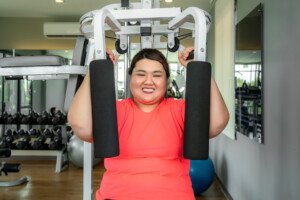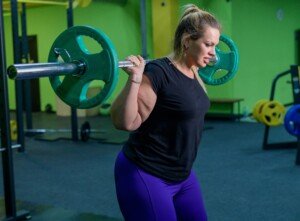
If you’re obese or overweight and are wondering which is better, barbells or machines for fat loss, fitness and toning, I have the perfect answer for you.
I was a personal trainer at a large gym some years back, so I know all about the virtues of barbells vs. machines – -whether you’re obese, thin or somewhere in between.
If you’re brand new to strength training, you can use both barbells and machines, about 50/50.
The use of machines will allow you to more confidently develop conditioning and stronger joints.

Shutterstock/Travelerpix
A machine will also help your body get used to the feel of moving resistance — while at the same time, providing stability, especially to the lower back.
Pros of Machine Weights for Plus Size
Machines will help get your body introduced to strength training without requiring the balance and core stability that’s needed with many barbell exercises.
Secondly, machine workouts are done while seated, so that if the plus size exerciser has knee problems or finds standing uncomfortable, they can strength train more comfortably while sitting.
Pros of Barbell Training for the Overweight
Barbells, when used for exercises that have a machine comparable, work more muscles.

Shutterstock/Reshetnikov_art
More muscles worked means more fat burned and more fitness generated. Free weights engage the core much more (lower back and abs).
Plus, the best exercises in terms of burning fat, developing strength and fitness, and shaping the body, involve barbells: deadlift, squat, bench press, incline press and overhead press, to name a few.

Shutterstock/Nomad_Soul
Using a barbell will also more closely mimic real-life movement. This means it’s more “functional” than a perfectly designed and stabilizing machine.
Negatives of Using Machines
These are the same disadvantages for any body size, and that’s the limited range of motion.
It’s fixed; same angle and hand position every time, though some equipment offer several different gripping positions and a seat height adjustment, which alters angles.
Depending on the equipment, a chest support pad can be adjusted closer to you, and a seat can be adjusted closer to a foot platform (and vice versa).
Nevertheless, you still have far more choices with barbell training.
Machines also tend to isolate muscle groups, and though there’s nothing wrong with this, a workout program should not be based upon isolation moves, because a body’s natural movement does not isolate muscle groups.
Negatives of Barbell Training
Many barbell exercises involve standing, though some can be done while seated or lying down.
The disadvantages also apply to thinner people, in that some people will find it awkward to execute certain movements, even with light weights, such as the back squat and bent-over row. But with practice comes mastery of form.
Injury is more likely with a barbell, for any body size, though machines do not guarantee avoidance of injury, either.
Plus size men and women should get started with both machines and barbells.
But as their conditioning improves (and that will be rather rapidly as long as they’re consistent and using challenging amounts of resistance), they should shift most of the focus to barbells — and also include some dumbbell work.
 Lorra Garrick is a former personal trainer certified through the American Council on Exercise. At Bally Total Fitness she trained women and men of all ages for fat loss, muscle building, fitness and improved health.
Lorra Garrick is a former personal trainer certified through the American Council on Exercise. At Bally Total Fitness she trained women and men of all ages for fat loss, muscle building, fitness and improved health.
.

























